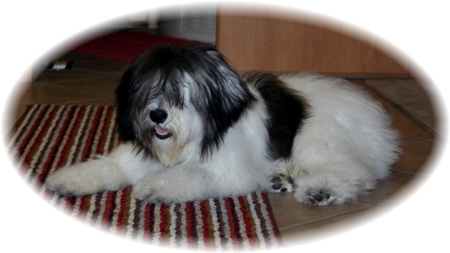|
PONS who are experiencing pain will likely draw your attention to their
dormant suffering by giving you clues as to the source of their
discomfort For example, a PON with abdominal pain will persistently
glance toward his tummy, bite or lick the area, and will not want to
leave his resting area. A PON may stand hunched over,"flop" or
get down on it’s forelegs with the hind legs still standing, because of
pain in the abdomen area.
PONS can not tell you that they are feeling pain or cry but but may
vocalize their pain in a different way. A dog that is hurt suddenly (such
as being stepped on) will cry out or wimper in pain. This also happens
when an external injury or internal injury (such as an organ) is touched.
Whining or vocalization that is unprovoked may be caused from an internal
injury as well. Some breeds have a higher pain threshold and need to be
watched more closely for signs of pain. Breeds with a high pain tolerance
are more likely to endure the pain without vocalization. Some may widely
open their mouths without making any sort of sound.
A change in temperament is another indication of pain. A dog that is
in pain may show signs of aggression. Please take note of this before
concluding that your PON has become vicious and let your veterinarian know
so that the correct treatment can be prescribed. Further, females going
into heat may have days when they are just in a bad mood for no obvious
reason. Take note of days of times that these mood swings occur as well as
any events that might have triggered them.
These conditions may trigger pain:
•Ears: discharge, odor, scratching, twitching or shaking.
•Eyes: redness, swelling or discharge.
•Nose: runny, thickened or colored discharge
•Coughing, sneezing, vomiting or gagging.
•Shortness of breath, irregular breathing or prolonged/heavy panting
•Evidence of parasites in the dog’s stool, strange color, blood in the
stool, or lack of a bowel movement (constipation)
•Loss of appetite or not drinking as much water as normally would.
* Arthritis: joint issues, inflammation
There are more symptoms, but these are just some major signs to watch out
for as pain triggers. Please seek the help of a veterinarian and when
considering pain medications, consult PON Digest's PON Health reports
section listed on the front page of this site. PON owners should consider
asking their vets to test for the mutant DMR1 gene in order to prevent
tragedies. Owners need to protect their PONS by staying updated on the
latest medical advances and by doing their own independent research. Being
a dedicated PON owner means more than grooming and offering an upscale
diet. It means being an independent thinker. |
|

